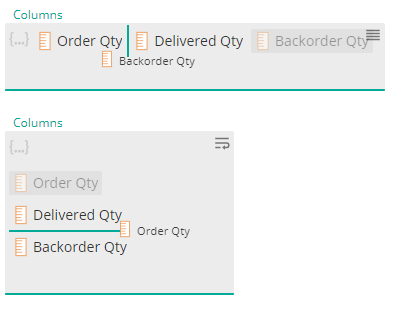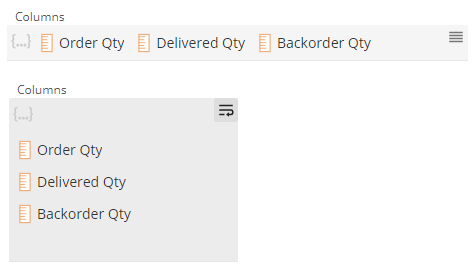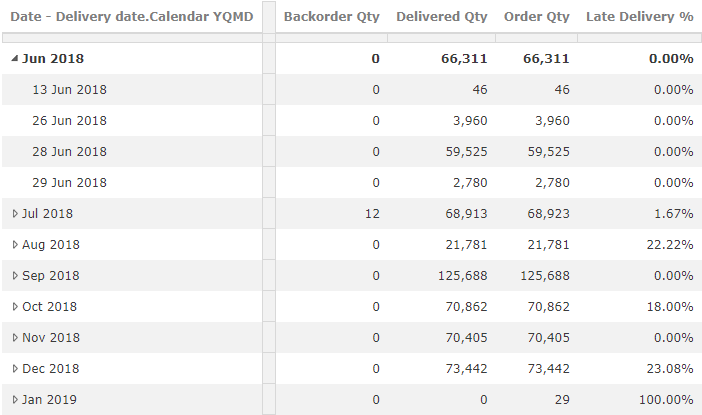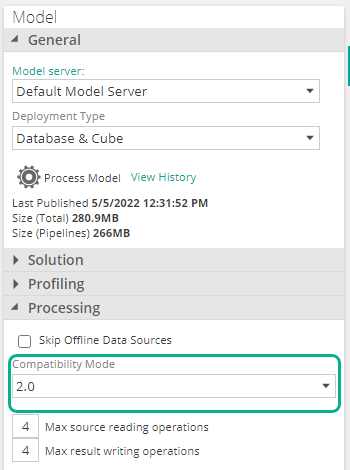Cloud release notes May 2022
Release number: K57
Analytics enhancements
User Interface improvements
The following changes have been made to improve usability in Data Hub.
Dragging objects in placeholders has been improved by showing a | character to help find and indicate where the object will be dropped

Placeholder toggle switch: In the top right of each placeholder, a new toggle switch is available that will arrange tabs vertically or horizontally. Choosing vertical will result in one tab per row.

Analysis formatting has been improved with styling like bold column headers, better spacing, text alignment based on datatype and more.

Moving (copy / cut / paste) objects between folders in the resource explorer will show an icon while the action is in progress.

Improved error handling
Modeling enhancements
New connectors
Column store indexes
Data Hub now automatically creates clustered column store indexes (or sometimes referred to as columnar indexes) behind the scenes. In most scenarios, you will notice a reduction in datawarehouse size thanks to better data compression. Column store indexes have many benefits and should improve data migration time, as well as various other transformations.
To enable column store indexes to be created, set the Compatibility Mode to 2.0 on the Model properties pane, in the Processing section.

Additional Semantic Layer Storage: Tabular
ZAP is adding support for a new semantic layer type: Tabular, which is in addition to the currently-generated Multidimensional semantic layer type (also commonly referred to as cubes).
This added type manifests as two new Cube environment types in a Model Server resource, namely: SSAS Tabular when deployed on SQL Server on-premises, and Azure Analysis Services when deployed to a proprietary Microsoft Azure subscription.
In version 10.1 on-premises, and cloud versions of Data Hub, from the April 2022 update (Release 56), this feature is available as a Beta release.
The FAQ's below will assist in your decision to determine whether this new engine type is appropriate for use by your organization.
Tabular FAQ's
Important
This release ONLY supports modeling scenarios, not reporting scenarios from ZAP.
What is SSAS Tabular, and what are the differences with Multidimensional and Azure Analysis Services?
SSAS Tabular is a native column-store based storage engine, introduced in SQL Server by Microsoft in 2012, and perfected ever since. It is the engine that powers data sets in Power BI. In recent years the Tabular engine was also released as an enterprise managed service in Azure, called Azure Analysis Services. Multidimensional engine has remained an on-premises SQL Server engine, only.
While Tabular and Multidimensional engines are similar functionally, there are notable and important differences in terms of their hardware requirements, compression levels, querying methods, programming languages, and also with their respective modeling requirements.
Why is ZAP releasing this new semantic layer type?
ZAP did not and does not require supporting Tabular for its own reporting and visualizations, but it is a requirement and expectation for users of Power BI, or organizations who leverage ZAP Data Hub as an integral part of their BI topology in Azure. Only the Tabular engine is supported as a managed service in Azure.
Am I licensed to use this new type?
Yes, Tabular engines are available as an option in Model Server resources starting from Data Hub 10.1 or Release 56 in the cloud.
Do all Data Hub features work with the new Tabular engine type?
Most data modeling features work with Tabular. However, it is critical to note that reporting and visualization resources of Data Hub do not and can not query a data model generated on SSAS Tabular or Azure Analysis Services, yet.
What are the scenarios for using the new Tabular types?
If you use or intend to use the prebuilt ZAP Analytics or create new reports, visualizations and dashboards from Data Hub, you do not have and should not use the new Tabular engine. Data Hub does not support querying a ZAP-generated Tabular model yet.
The main scenarios for using this new Tabular engine, are:
If you already have investments in Tabular models, and have a SQL Server instance of Analysis Services Tabular, or organization staff trained on this technology
If your organization uses Power BI.
If your organization would like to govern their data and materialize their semantic layer in a Tabular model rather than connecting Power BI to the ZAP-generated datawarehouse.
If your organization plans to leverage Azure Analysis Services in their Azure subscription.
I have an existing data model generating Multidimensional models, can I upgrade to a Tabular data model?
Yes. Data Hub will create a backup resource too.
What is the minimum required compatibility level on-premises?
ZAP requires Analysis Services compatibility level 1200 or higher. To this date, it is the minimal supported compatibility level of Azure Analysis Services.
Do ZAP pre-built solutions work with the new Tabular Types?
Some of the design principles of Tabular models are different compared to Multidimensional models. For example, a Tabular model does not differentiate between a dimension or a fact table, even if it is a best practice to model data as star-schema, it does not support the concept of attribute keys and attribute names, it requires ordering name columns by the key which is the opposite of a Multidimensional model, and requirements for modeling data is slightly different in order to be optimized, parent-child hierarchies are also not natively supported by a Tabular model.
Therefore, an upgrade path from a data model built in Data Hub with a Multidimensional model output is not simple. But in order to facilitate such upgrades to Tabular, Data Hub v10.1 and release 56 in the cloud have introduced upgrading to Tabular.
Row or object level security is not available. Due to the structure of data stored in columns and not rows, this functionality is not available.
Data Hub analytics for tabular is not available in this release.
Many-to-Many relationships in tabular is not supported.
Tabular doesn't allow Bi-directional relationships.
No validation on DAX measures
The following new validation errors will be present for tabular modeling:
Relationships with Ambiguous paths
Relationships that create cycles
DAX measures that doesn't have a name
DAX measure names that are not unique
Model design in tabular differs significantly from multidimensional modeling. To get started and understand the differences read more about Getting started with tabular modeling
API integrations
New APIs are made available for developers to build App integrations with Data Hub.
The Model Data API enables interfacing with datawarehouse data through a new dynamically-generated OData API.
The Legacy Data Model Process API (HTTP) enables the processing of data models or parts there of programmatically without using the UI.
Performance Enhancements
Every release contains performance enhancements and bug fixes to improve Data Hub.
Date of publication 14 May 2022